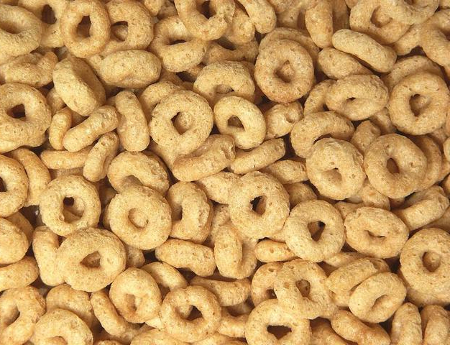Cheerios are a breakfast cereal made from puffed oats in a distinctive ‘O’ shape that have been popular with children and adults alike since the 1940s. The Cheerios brand is owned by General Mills, a US based cereal company and are also marketed by Nestle in the UK and as many as 130 countries where Nestle operate. Cheerios are available in a wide range of flavors and styles, and are advertised as a healthy nutritious breakfast.
19th century breakfasts were typically made up of fried eggs, sausages, bacon, perhaps with toast as well. A healthy diet wasn’t yet considered very important yet a number of medical professionals working in sanitariums had noticed their patients responded better to bowel and urinary tract problems, even to mood swings, if they ate a more balanced diet filled with vegetables and cereals. Unfortunately, cereals proved difficult to make into convenient meals and a number of experiments were attempted that would produce bite-sized cereal nuggets.

It wasn’t until the 20th century and modern food presses and pressure cookers that cereals were able to be used as the main ingredient. The first breakfast cereals such as corn flakes and grape nuts were marketed around the turn of the century and sold surprisingly well encouraging other mills and sanitariums to develop their own cereal brands, amongst them being General Mills which first entered the breakfast cereal market with Wheaties.
Cheerios, made from puffed oats were first released in 1941, but nearly didn’t happen at all. The inventor of Cheerios, Lester Borchardt and a team of people at General Mills had tried to invent a machine they could use to create puffed cereal such as puffed wheat and after spending a great deal of money and time on the technique without result they were told by Borchardt’s boss to quit the project. Borchardt was a headstrong employee who knew the idea was sound and decided to keep developing the machine. Two months later they were rewarded with success and General Mills had a new product.
Cheerios were marketed quite aggressively as Cheeri Oats, but another company was already using the name and after a short dispute General Mills management agreed in 1945 to change the name to Cheerios, a name it has kept to the present day. Beginning in the early 1940s, around the time the Cheerios brand was being marketed the company created a cartoon character named Cheeri O’Leary as its brand mascot. Television hadn’t reached critical mass yet so the character was used in both animated form and printed form proving popular with children.
Competition with Kelloggs who had deep pockets and a loyal following required innovative thinking, and General Mills under the direction of the company owner James Bell were inspired to sponsor a radio show aimed at children yet with a moral story to every episode, and by a happy coincidence the creator of the Lone Ranger was in need of a sponsor to get the show syndicated throughout the United States beginning in 1949. The association with the Lone Ranger endured for 20 years and helped propel Cheerios into the top spot as the most popular breakfast cereal.

In the early 1950s Cheerios developed a new character to replace Cheery O’Leary who had become dated. Television viewing numbers were at a point that Cheerios could now be marketed on TV exclusively resulting in the Cheerios Kid and Sue hitting the airwaves. Typically the ads would show Sue getting into a difficult situation and calling for help from the Cheerios Kid who would use a combination of muscle and intelligence to come up with a solution to her problem and in so doing reinforcing the message that Cheerios were a healthy breakfast.
Further advertising innovations invented by General Mills were the idea that the packaging for Cheerios needn’t contain only the cereal. Through the late 1940s and 1950s General Mills marketing department successfully co-branded boxes of Cheerios with the Disney company to offer exclusive discounts on comic books, and then as advertising for the newly launched Mickey Mouse Club in 1956. By 1961 the association with the Lone Ranger offered an opportunity to increase sales of Cheerios cereal with a joint release of Lone Ranger and Silver action figures inside the cereal box, an innovation that took the cereal world by storm and revolutionized product marketing.
The Cheerios brand was also used to good effect in the mid 1960s when its packaging was chosen as the main vehicle to promote a new social and charitable endeavor started by General Mills known as Project Head Start. A small percentage of the earnings received from the sale of every box of Cheerios was donated to the foundation with the goal of providing education and healthcare services to disadvantaged families in the US.
Aware that Cheerios were facing competition from new cereal brands that were sweeter and more colorful, Honey Nut Cheerios are added to the supermarket shelves in 1979, and heralding the start f new research into alternative flavors and varieties of Cheerios which saw the introduction of the Apple Cinnamon flavor in 1988, MultiGrain Cheerios in 1992, Frosted Cheerios in 1995, Millenios in 2000, and Berry Burst Cheerios in 2003.
Healthwise Cheerios have been well received, starting with claims from General Mills that Cheerios provide all of the “essential nutritional values of oatmeal”, a claim proven in 1988 when studies prove oat bran helps in the fight against high cholesterol. By 1999, and after a rigorous evaluation of all breakfast cereals, Cheerios is declared the only cereal able to help reduce cholesterol in populations needing a low fat diet and is endorsed by the Heart Foundation as a recommended breakfast.